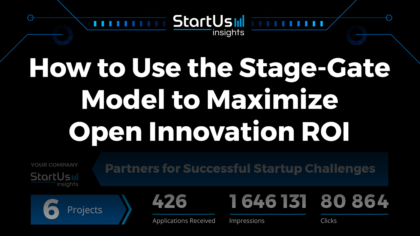Accelerate Productivity in 2025
Reignite Growth Despite the Global Slowdown
The stage gate model allows companies to fast-track innovation by defining and managing the different stages of innovation. It improves corporate teams’ ability to measure progress and track results, optimize resource allocation, and streamline decision-making processes. In addition, the stage gate framework enables organizations to assess business opportunities and risks associated with new products or services, identify areas for process improvement, and develop plans for commercialization. As an important part of an organization’s overall innovation strategy, the stage gate model is increasingly used in open innovation strategies.
In this report, learn what the stage gate model is, its utility for open innovation, and how to accelerate your innovation agenda by taking this approach.
Advantages of the Stage Gate Model for Open Innovation
The stage gate model, also known as a phase-gate process, is a popular tool in project management. It allows managers to identify new ideas to pursue and simplifies allocating resources to them. As more and more companies embrace open innovation, innovation managers are also using stage-gate ideation to strengthen their innovation pipelines.
However, implementing stage-gate ideation in open innovation requires slight changes to how it is done for internal project management. Following are the ways it differs:
- Evaluation criteria. Unlike internal project management, stage-gate ideation for open innovation requires you to evaluate both internal and external capabilities. External capabilities include, but are not limited to, those of your partners, customers, and promising startups you collaborate with.
- Import of external capabilities. You need to systematically gather and analyze the know-how and technical knowledge of external partners.
- Export know-how and technology. To make the most of open innovation, you need to evaluate both internal and external paths to market your products and services.
- Continuous evaluation of internal capabilities. In stage-gate ideation for traditional project management, managers only evaluate if product development fits the company’s model and core technologies. To maximize open innovation, you need to continuously evaluate your business models and technologies to stay on par with your competitors.
How Stage-Gate Ideation Makes Open Innovation Successful
Systematic management of innovation initiatives. The stage-gate innovation framework improves the structuring of open innovation milestones. It provides a systematic approach for managing innovation projects, from ideation through to commercialization. By providing a clear roadmap, the stage gate model improves the success rate of innovation initiatives.
Efficient new product development. The framework improves the delivery of new products or services. It eliminates potential risks or errors in the product lifecycle, ensuring that new product development proceeds in a timely and efficient manner.
Improved collaboration. Stage gate ideation improves collaboration both internally (between cross-functional teams) and externally (with startups or other partners), ensuring that all key stakeholders are aligned on the goals.
Effective value creation. Implementing the stage gate model contributes to better decision-making at all steps of the innovation pipeline. In turn, this maximizes value creation in alignment with your company’s strategic objectives.
Read this report: How Open Innovation Creates Value for Your Customers

What the Stage Gate Model Looks Like
The stage gate process is described as a five-stage approach from ideation to product launch with a gate between every two stages. Each stage advances product innovation significantly and thus requires greater resources than the previous one. With each stage, the number of possible routes keeps getting narrower until you’ve developed one or a few products. Each gate requires you to answer a few questions before you can proceed to the next stage.
Here is what the stage gate generally looks like:
Stage 1: Ideation
In this stage, innovation managers generate ideas from a variety of internal and external sources. Invariably, these are challenges to overcome or new areas of growth. Some of these include:
- Intrapreneurship: When companies foster a culture of intrapreneurship, individual business units, and employees are better equipped to identify bottlenecks as possible targets for innovations.
- Idea generation: Innovation managers use a range of techniques to generate and manage new ideas from within and outside the company.
- Customer feedback: Customer feedback is also a great source of new directions for your products. Customer-centric innovation ensures that your products are in alignment with changing customer trends as well as opens up opportunities for co-creation.
Read this report: Serve Customers Better with Customer-based Innovation
Gate 1: Ideation Screen
- What business challenges do you need solutions for?
- What kind of solutions are you looking for?
- Do you need external innovation to tackle these challenges? (Spoiler: Yes, you do!)
Stage 2: Scoping
After identifying problems, the next stage involves casting a wide net for potential solutions. This ensures that you have a broad view of emerging technologies in your industry and understand how they can solve your challenges. To do this, innovation managers traditionally relied on their networks or trade events. This took months and cost a lot of money.
Today, AI and data-driven open innovation tools such as the StartUs Insights Discovery Platform make it fast and affordable, while providing greater coverage than manual scoping ever could. Covering detailed information on over 3 million startups and scaleups globally as well as over 23 500 technology trends, our Discovery Platform ensures that you don’t miss a single relevant solution. Here are a few ways it streamlines scoping for you:
- Technology Scouting: When your innovation goals are well defined, technology scouting allows you to identify emerging technologies that advance those goals. The Discovery Platform provides you with an exhaustive and accurate list of technologies that tackle the challenges you’re facing.
- Startup Scouting: Data-driven startup scouting identifies the most relevant startups for your innovation goals. For your startup scouting needs, the Discovery Platform offers industry-leading exhaustiveness and precision. This means that you don’t miss out on any relevant startups or waste time sifting through irrelevant startups.
- Trend Intelligence: When you’re not looking for a specific solution, trend intelligence is a broader alternative to technology scouting. Giving you deep insights, the Discovery Platform instantly identifies emerging and latent trends and developments that will impact your competitiveness in the long term.
Read this report: How Data-Driven Trend Intelligence Future-Proofs Your Business
Gate 2: Second Screen
- Which technologies can solve your challenges or create new opportunities for your business?
- Which startups are building these technologies?
- How market-ready are these technologies?
Stage 3: Business Case
Great technologies don’t necessarily guarantee great products. Before moving to development, you need to build a business case for how the technologies will translate into products. This requires a careful overview of the readiness of technologies as well as exploring different business models. Some of the steps that mark this stage of the process include:
- Competitor Intelligence: A product may not be worth your time or investment if you can’t make it cheaper than your competitor. Competitor intelligence provides data-backed projections on your competition to ensure you focus your resources on products that can give you a competitive advantage.
Read this report: How Data-driven Market Intelligence drives Innovation
- Build-Buy-Partner Decisions: After evaluating promising technologies and startups, companies generally have these three options. They can either build the solutions themselves, acquire the startups, or partner with startups. While these kinds of decisions aren’t new for companies, innovation intelligence provides richer insights to make informed decisions.
Gate 3: Go to Development
- What is the timeline of product development?
- If you are building the product in-house, what core competencies do you need?
- If you are acquiring a startup, how do you plan to incorporate its resources and talent into product development?
Stage 4: Product Development
Effective product development is critical to the success of a company’s innovation pipeline and its long-term success. Since the principles of the stage gate model find their roots in project management, this is also the stage where they apply the best. A range of innovation intelligence services improves the speed and efficiency of this stage of stage gate ideation. Some of these include:
- Product Intelligence: It streamlines product development and innovation in a single process. This allows you to achieve real-time collaboration between product, growth, and innovation teams. In turn, this improves quality control and speeds up new product development. Technology landscaping also finds use in product intelligence by benchmarking product development to existing technologies in the market.
Read this report: How does Data-driven Product Intelligence support Innovation?
- Product Portfolio Management: This provides you with a bird’s eye view of your entire product pipeline. It enables you to prioritize which products to focus on to optimize return on interest. Moreover, it provides data-driven insights on how to market your products for the next stage.
- Product Lifecycle Management: This provides you with a centralized source of information across the product value chain. In a way, it flips the stage gate process inside out with a focus on this stage and, therefore, has its own stages. This increases productivity and reduces time-to-market.
Gate 4: Go to Launch
- Do you need to kill any products during development to give others a better chance?
- Which features are must-haves in your products before launch?
- On launch, how do you intend to position your products?
Stage 5: Product Launch
Premature product launches can erode consumer trust. On the other hand, delayed product launches can cause your products to be outdated at launch. Therefore, effective planning is crucial to derisk product launches and maximize the competitive advantage of disruptive products. Here are a few ways you can achieve this:
- Market Intelligence: This allows you to identify threats and opportunities for your products. Data-driven market intelligence keeps track of both what your competition is doing as well as what your customers want. This ensures that you are better positioned to market your products.
- Gradual Product Rollouts: In the software industry, companies launch beta versions before rolling these out to all customers. Even if you’re not a software company, gradual product rollouts reduce risk from failed launches, enable continuous improvements, and increase profit margins.
Read this report: How Continuous Improvement Process supports Innovation
Accelerate Your Stage Gate Process with the Discovery Platform
The Discovery Platform enables a range of innovation intelligence services that accelerate your stage gate process. It derisks the process while streamlining product development, empowering your teams to create great products. Thanks to exhaustive insights into the world’s startups, emerging technologies, and innovations, it allows you to focus on implementing innovations rather than spending months just looking for them.
Here are a few features that make the Discovery Platform the best platform you can use for your product innovation journey:
- Covering over 3 million startups and scaleups globally, the Discovery Platform is the most exhaustive repository of startup activity in the world. This includes under-the-radar startups that other innovation intelligence tools miss.
- It features a powerful, proprietary semantic search technology that allows you to identify highly relevant startups in just a few clicks, replacing weeks of desk research.
- Its intuitive interface features multiple filters to narrow down your search as well as provides you an option to export the results.
- The Discovery Platform provides you instant access to the most relevant technology trends for your industry.
- For any technology trend, it provides you with detailed information on main drivers, core investors, growth, and other insights.
Stage gate innovation enables you to pursue more open innovation activities. Combine it with open innovation and the possibilities are limitless for your innovation pipeline. To boost your product innovation, book a demo today!


![Future of Robotics: 12 Trends Powering the Next Wave [2025-2030]](https://www.startus-insights.com/wp-content/uploads/2025/06/Future-of-Robotics-SharedImg-StartUs-Insights-noresize-420x236.webp)
![Innovation During Recession: Key Data-Driven Strategies to Thrive [2025-2026]](https://www.startus-insights.com/wp-content/uploads/2025/06/Innovation-during-Recession-SharedImg-StartUs-Insights-noresize-420x236.webp)
![Business Resilience Planning: 10 Strategies & Technologies to Tackle the Current Market [2025-2026]](https://www.startus-insights.com/wp-content/uploads/2025/06/Business-Resilience-Planning-SharedImg-StartUs-Insights-noresize-420x236.webp)



